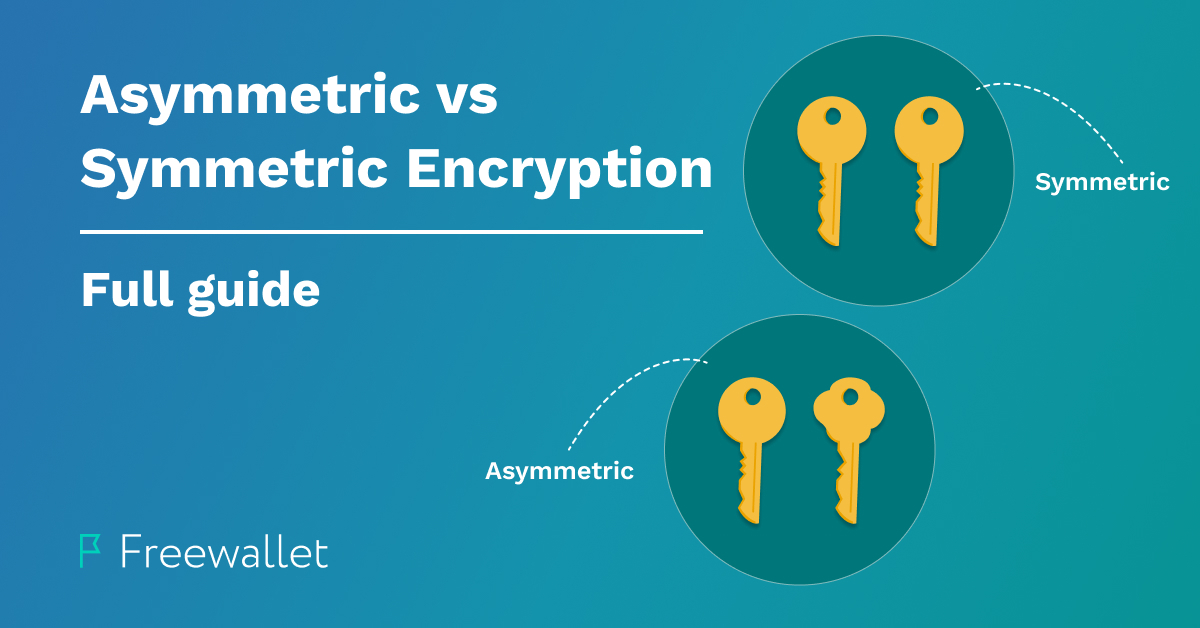
It is considered that as of February 2024, over 425 million people own cryptocurrency. It means that roughly every 20th person on Earth has some cryptocurrency. The overall crypto market capitalization amounts to $2 trillion. We can’t take the safety of all of this cryptocurrency for granted. The blockchain-based platforms and digital currencies exist under the constant fire from cybercriminals whose methods of stealing crypto elevate and challenge existing protection measures all the time.
Encryption is a crucial element in the architecture of the security of cryptocurrencies. As cryptocurrencies are supposed to work as a self-sustained system, no one is in charge of keeping the blockchain data (including your funds) safe. Of course, the apps providing interfaces for managing cryptocurrencies add a protection layer, but at the end of the day, it is encryption which does the biggest chunk of job to protect your data.
This article reviews the two types of encryption: symmetric and asymmetric encryption, where the former is the encryption using a single key to encrypt and decrypt data while the latter relies on two different keys, one for encryption and the other for decryption (public and private keys). We are going to highlight pros and cons of each encryption type and explain how they work.
What Is Symmetric Encryption?
Symmetric encryption is a cryptography in which all the parties involved in communication use the same key for encryption and decryption of messages. Without equal access to this key, sides won’t be able to communicate.
Image source: The SSL Store
For instance, you send an encoded text message to your friend and attach the key you used to encrypt your message. Your friend will be able to decrypt it using the same key and read. To maintain secrecy of communication, all involved parties should avoid sharing the key to parties not involved in the communication.
How Does Symmetric Encryption Work?
Symmetric encryption works two ways: through block ciphers or via stream ciphers. Block ciphers split the input data into pieces all of the same size while stream ciphers encrypt every bit of data linearly.
Image source: LinkedIn
Such factors as the size of the block, the number of coding rounds, and the length of the key influence the overall efficiency of the symmetric encryption algorithm. One of the most popular algorithms is AES256. It splits the data into 128-bit blocks and utilizes a 256-bit key. Sender and receiver must have access to the key in order to communicate.
Examples of Symmetric Encryption
Symmetric encryption provides speed and precision in encoding and decoding while being a pretty strong protection measure. That’s why this type of encryption is in high-demand among the developers of the apps in the spheres associated with privacy and integrity. This includes the platforms operating online communication and requiring encryption of the sensitive data from messages to files.
The particular examples of the apps using symmetric encryption are such messengers as WhatsApp and Signal. The Signal Protocol used in the Signal messenger provides an end-to-end encryption, meaning that no data circulated between two devices is unencrypted and only the parties involved in messaging can read the original content.
Encryption programs like VeraCrypt and AxCrypt use symmetric encryption as well. They employ an AES algorithm to protect the data stored on various devices. In the event of the device appearing in the hands of criminals they won’t be able to obtain sensitive data. The US government uses AES256 for protection of classified information.
Another common use of asymmetric encryption is virtual private networks, also known as VPNs.
Pros and Cons of Symmetric Encryption
It may seem that symmetric encryption is not that safe, but in fact it has many benefits to offer. See the list below:
Pros:
Strong protection: Symmetric encryption provides top-notch data protection. The fact that AES256 is one of the most used algorithms proves it.
High speed: Symmetric encryption is the fastest type of encryption. As it uses a single key for encoding and decoding, the encryption and decryption procedures don’t take much time.
Efficiency: This type of encryption requires little computation power which allows it to save resources.
Ease of use: Symmetric encryption is popular among application developers as it’s easy to implement because it requires only one key. Moreover, this type of encryption works well with most systems and devices.
Cons:
Aside from benefits, symmetric encryption has a flaw. Although symmetric encryption is very secure, there is still a possibility of a data leak. As the wrongdoers need only a single key to access the data, they can target and steal it. Asymmetrical encryption using two keys make it more difficult for thieves to steal data.
What Is Asymmetric Encryption?
The definition of asymmetric encryption will sound familiar to those who know the crypto wallets structure a bit. Asymmetric encryption is characterized by the use of a pair of keys instead of a single key. None of two keys is enough to encrypt and decrypt the data.
Image source: The SSL Store
A public key encodes the data and a private key decodes it. This type of encryption makes it harder for intruders to get access to the sensitive data.
How Does Asymmetric Encryption Work?
As the name suggests, a public key can be available for anyone for data encryption. If this key is obtained by criminals, data stays unaffected because it’s secured via a private key needed for decryption. The private key should be kept securely and must not be shared to anyone including the counterparty in the transaction/communication.
Examples of Asymmetric Encryption
Asymmetric encryption is widely used in cybersecurity. It powers integrity, safety, and mutual interdependence of communicating parts in the apps and platforms where any form of confidential communication takes place.
Cryptocurrency wallets are the prime example of the asymmetric encryption implementation. Also, asymmetric encryption is used for the website security protocols such as Secure Sockets Layer (SSL) and Transport Layer Security (TLS). It protects the data circulating between the user’s Internet browser and the website.
This type of encryption is used in the secure email communication protocols such as Pretty Good Privacy (PGP) or Secure/Multipurpose Internet Mail Extensions (S/MIME). The email content is encrypted via a public key while the receiver having a private key can read the content. No one else can access the contents of these emails.
On top of that, asymmetric encryption is used in the digital signatures-services like Adobe Sign or DocuSign. When you sign something digitally, you use your private key. The integrity of this signature is verified by the recipient through the public key.
Pros and Cons of Asymmetric Encryption
Now, let’s take a look at the benefits and flaws of asymmetric encryption:
Pros:
Top-notch security: Breaching the protection of data secured via asymmetric encryption is really hard. This type of encryption doesn’t require a protected channel for key distribution as any involved party has a unique private key. Interestingly, asymmetric encryption is sometimes used to secure the transmission of the symmetric encryption key between the parties involved.
Non-repudiation: This means that the party sending a message or funds cannot deny the fact of sending it as it can be traced back to the private key of the sender.
Good for authentication purposes: Asymmetric encryption allows any amount of people to verify a digital signature you left. It significantly simplifies many situations where online/digital authentication is required. More than that, it’s safe to say that asymmetric encryption is good for various purposes.
Cons:
As for the flaws of asymmetric encryption we can name a bit lower speed in comparison to symmetric encryption. However, this flaw is relative. Also, asymmetric encryption is harder to deploy for devs.
Conclusion
The crucial difference between symmetric and asymmetric encryption is that the former uses a single key to encrypt and decrypt the data while the latter uses a pair of private and public keys. The use of a single key makes encryption faster, cheaper, and easier to implement. The use of two keys opens more opportunities and use cases while compromising speed and resource efficiency a bit. The safety level provided by asymmetric encryption is higher than the level of symmetric encryption.
Related
Stay tuned
Subscribe for weekly updates from our blog. Promise you will not get emails any more often.
Most Popular
New Posts
Stay tuned
Subscribe for weekly updates from our blog. Promise you will not get emails any more often.







